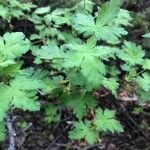Plants 0.7-1.5 m. Stems spread-ing or decumbent, copiously pubescent, puberulent, and stipitate-glandular; spines at nodes 1-5, (1.5-)4-6(-10) mm; prickles on internodes sparse to dense. Leaves: petiole 0.7-4(-5) cm, pubescent, stipitate-glandular; blade pentagonal, irregularly 5-lobed, cleft 2/3-3/4 to midrib, (0.5-)1-3.5(-4) cm, base cordate, surfaces densely pubescent or stipitate-glandular, lobes cuneate-rounded, margins irregularly serrate, toothed apex somewhat acute. Inflorescences pendent, 3-8 (-11)-flowered racemes, 2-3 cm, axis puberulent, stipitate-glandular, flowers evenly spaced. Pedicels jointed, 1-4(-5) mm, puberulent, stipitate-glandular; bracts lanceolate-ovate, 1.3-3 mm, puberulent, stipitate-glandular. Flowers: hypanthium pinkish to orangish, saucer-shaped, 0.5-1.5 mm, pubescent and stipitate-glandular abaxially, glabrous adaxially; sepals separated, spreading, green to yellowish, pink, red, orange, or white, sometimes with pale yellow, scarious margins, broadly ovate to obovate, 2.5-4 mm; petals widely separated, erect, red, pinkish, or purplish, cuneate-lunate, not conspicuously revolute or inrolled, 0.9-1.5 mm; nectary disc yellowish, pinkish, or red, flat, 5-angled, covering most of ovary; stamens as long as petals; filaments linear, (0.5-)0.9-1.6 mm, glabrous; anthers yellow or cream, oblate to transversely elliptic, 0.5-0.8 mm, broader than long, apex notched; ovary sparsely to thickly, usually purplish glandular-bristly; styles connate ca. 4/5 their lengths, 1.1-1.8 mm, glabrous. Berries somewhat palatable, bright red, obovoid-spheric, 5-10 mm, glandular-bristly.
More
A spreading shrub. It grows about 60 cm high. The twigs have prickles. There are also 3-5 spines at the nodes. The leaves are usually 1-2.5 cm wide. They have glandular hairs on both sides. The flowers are purple and in small groups. The fruit are bright red berries. They are glandular and have bristles.
Exposed ridges, open woods and slopes, talus; at elevations from 1,300-4,800 metres. By streams, in wet forests, ravines etc, in the sub-alpine zone.
More
It is a temperate plant. In Canada it grows on rocky slopes in mountain and alpine regions.

